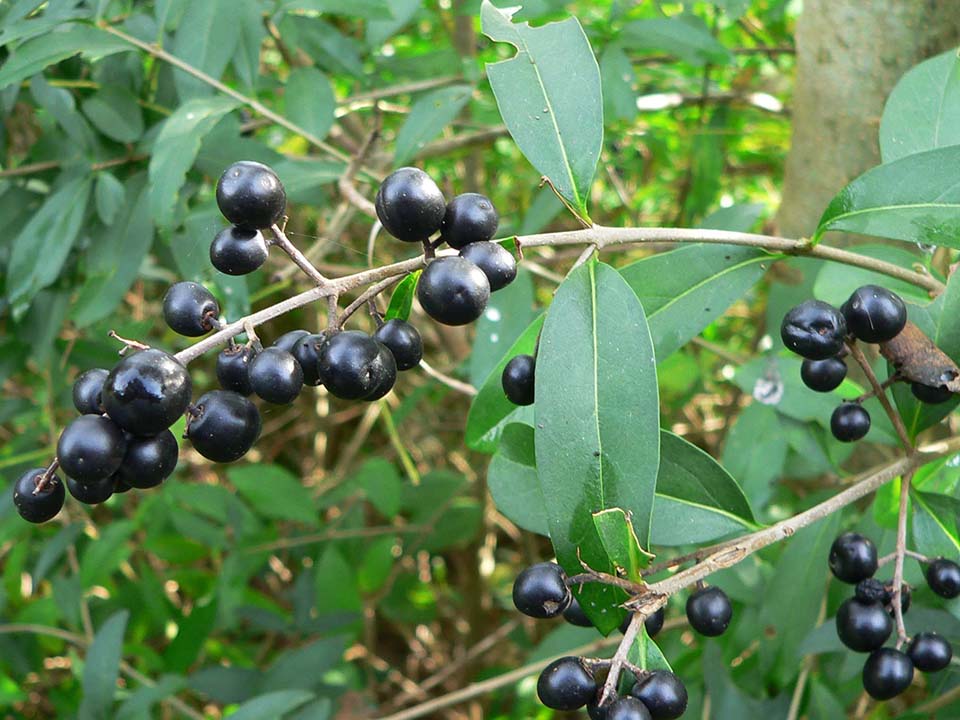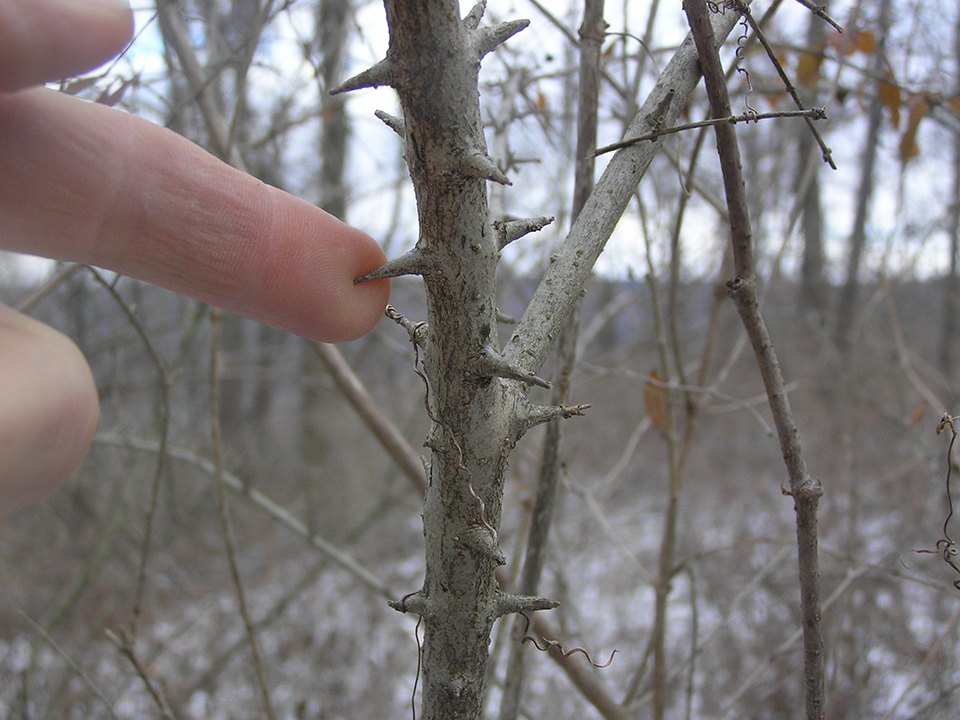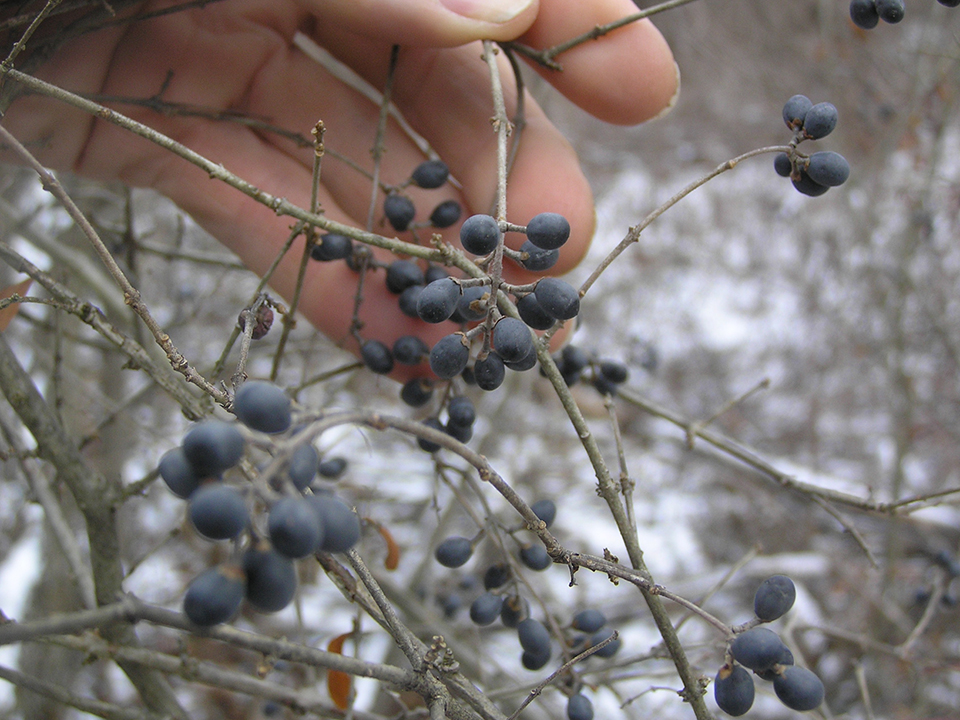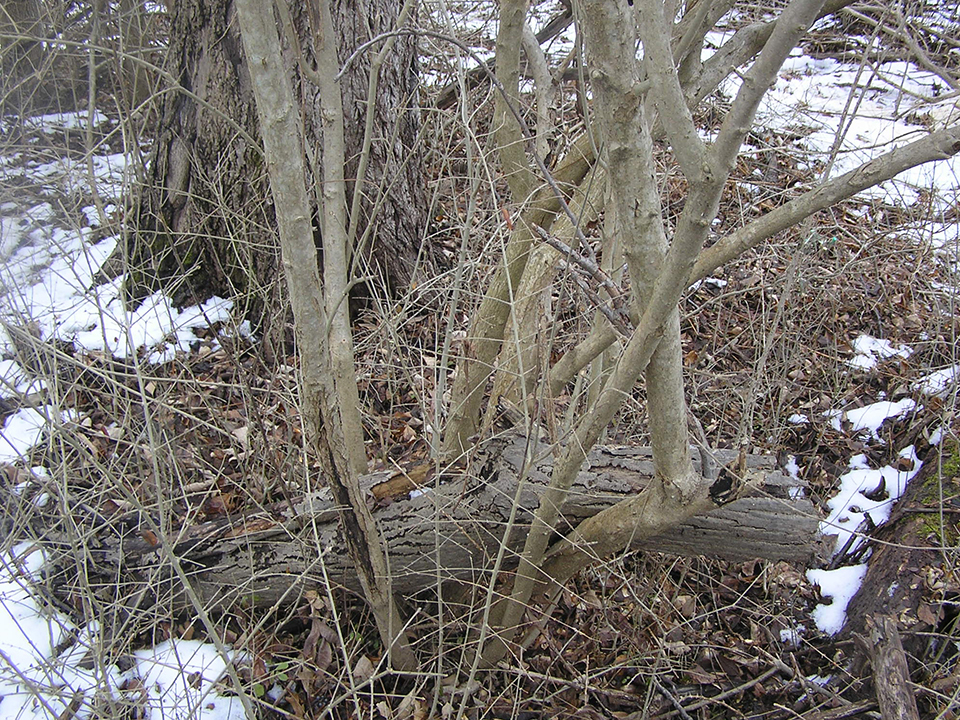
Fruit and leaves of common privet. Each fruit holds 2 to 3 seeds. Fruit remain on the plant into the wintertime. Leaves are opposite on the twigs.
Species Name: Ligustrum vulgare, Ligustrum amurense
Common Name: Common privet, Amur privet
Origin: Europe, northern China
Distribution: An invasive throughout the northeast, south and mid-west.
Identification: There are several similar species of privet that are all planted primarily for hedging purposes. It easily resprouts after shearing which aids in its use for hedging. For ease of discussion all species will be referred to as common privet. Privet is a large upright multi-branched shrub. The leaves are small, oval to round and positioned opposite on the twigs. Numerous thin lateral twigs branch at 90 degree angles along the main stem. The bark is smooth gray with warty pointed projections along the stems. Privet is a vigorous grower and can withstand heavy shearing. If left unpruned the stems can grow to 12 to 15 ft tall.
Diagnostic characteristics: Privet can be recognized from its light gray bark and the warty sharp projections along the stems where new twigs originate. Privet flowers in late spring producing white panicles on the ends of twigs. Fruit is a cluster of blue/black drupes hanging in clusters at the end of twigs. The fruit persists into winter. Twigs and branches fork at nearly a right angle (90 degree) from the stem.
Biology and Spread: Privet is tolerant of a range of growing conditions from full sun to shade and in most soils and moisture levels. Privet layers easily and any part of the plant touching the ground will initiate new roots. Privet produces large quantities of small blue/black fruits that remain on the plant throughout the winter. The persistence of the fruit encourages birds to eat the fruit and disperse it widely. Seed germinates readily creating a carpet of seedlings under mature plants.
Ecological threats: Privet commonly forms dense thickets, invading fields, fence rows, roadsides, forest understories, and riparian sites. Its rapid growth and prolific seed production enables it to dominate other most habitats. Privet has no significant insect or disease pests to limit its population expansion and spread. Deer do not browse on it.
The rapid growth and abundant seed production producing countless seedlings make privet eradication time consuming and costly.
Control methods:
1) Cut Stump Treatment:
For large stems use the cut stump treatment. The best tool for cutting multiple privet stems is a brush saw but loppers are useful as well. A chain saw may be used on larger stems but most stems are too thin and wiry for effective cutting by chain saw or even loppers.
As privet resprouts profusely from the stump after cutting, the cut surface needs to be treated with a herbicide. A 10% to 15% solution of glyphosate (the active ingredient in Round-up) is applied to the cut surface. A hand held spray bottle works well for applying the herbicide to each cut stem. Add a spray colorant to the bottle so you can tell which stems have been treated.
2) Foliar treatments
As privet produces large numbers of small wiry plants a foliar spray may be more efficient means of control. Wait until mid to late summer for treatment. Spray the foliage thoroughly with herbicide. Use a 2% solution of glyphosate with a spray adjuvant.
Wait a week or two and then evaluate whether to retreat any missed plants.
Follow up treatments and monitoring will be needed in subsequent years to control new seedlings and missed plants.
3) Manual Control
Young plants do not have a very well established root system enabling them to be easily pulled under certain conditions. Plants in loose sandy and loamy soils or in wet and loose spring soils are more easily pulled by hand or uprooted with a shovel, mattock or weed wrench.

Fruit and leaves of common privet. Each fruit holds 2 to 3 seeds. Fruit remain on the plant into the wintertime. Leaves are opposite on the twigs.

Notice the sharp
wart like projections along the stems and the grayish bark. Twigs usually fork at a 90 degree angle from the stem.

Fruit of common privet in winter. Fruit is a small
fleshy berry that remains on the plant into winter. Birds readily eat and disperse the seed because there is little else to eat.

A clump of larger privet stems and a dense matt of small privet seedlings carpeting the ground.